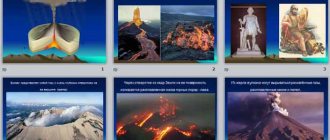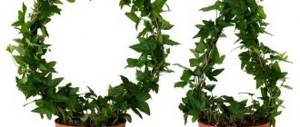Climate Features
The geographic location of the Arctic leads to very harsh weather conditions: almost the entire year the surface of the earth is covered with a thick layer of snow and ice, strong winds blow, and a blizzard can rage for several weeks in a row. The temperature of the Arctic desert zone in winter drops to -50-60C, and in summer rarely rises above 0C.
Starting from mid-autumn, the sun is no longer visible in the Arctic - this is how the polar night begins, which will reign for five long months. During this period, visibility in the Arctic deserts decreases, and it is possible to understand whether it is day or night outside only by looking at the clock.
Sometimes the polar night can delight you with an unusual natural phenomenon - the polar lights. Within a few minutes or even a few days, multi-colored iridescent flashes appear in the sky, which amaze with their beauty.
Rice. 1. Aurora
Arctic desert climate
The harsh climate contributes to the formation of ice and snow covers that persist throughout the year. The average temperature in winter is -30 degrees, the maximum can reach -60 degrees.
Due to the harsh climatic conditions, the Arctic desert is home to a small number of animals and virtually no vegetation. This natural area is characterized by strong hurricane winds and blizzards. Even in summer, desert regions receive minimal light, and the soil never has time to fully thaw. During the “hot” season, the temperature rises to zero degrees. As a rule, the desert is cloudy and often rains and snows. Due to the strong evaporation of water from the ocean, the formation of fogs is observed.
The Arctic desert is adjacent to the North Pole of the planet and is located above 75 degrees north latitude. Its area is 100 thousand km². The surface occupies part of the territory of Greenland, the North Pole, and some islands where people live and animals live. Mountains, flat areas, glaciers are components of the Arctic desert. They can be of different shapes and sizes, and have a distinct patterned structure.
Table “Characteristics of the natural zone of Arctic deserts”
| Natural area | Arctic desert |
| Zone position | The Arctic Ocean, all the seas and islands belonging to it. |
| Climate | The winter is long and very cold. Summer is also cold and short. During the year there is a polar day and a polar night. |
| Plants | Lichens, mosses, polar poppy. |
| Animals | Polar bear, seal, walrus, whale, killer whale. |
| Birds | Loon, puffin, guillemot. |
| Occupations of the population | Fishing, hunting, cargo transportation on ships, scientific research work. |
With the arrival of spring, the polar night recedes: the sun appears in the sky again, daylight hours begin to gradually increase. In the period from May to June in the zone of Arctic deserts and semi-deserts, the sun shines constantly - the polar day comes into its own.
Arctic Desert Post Report
When we hear the word “desert,” the imagination brings to mind images of vast sandy distances, the heat and vegetation inherent in this territory. To some extent this image is accurate. But there are also ice deserts, they are radically different from sandy deserts. There is no humidity due to the permafrost.
The Arctic, little-studied areas on the planet. There are only mountains, glaciers and plains. These deserts are located in the Arctic zone. The length of a day or night is calculated in months. At night everything is illuminated by the moon, stars and aurora. But there are also warm areas surrounded by warm waters - this is the Kola Peninsula.
Most expeditions were unsuccessful; only in the 20th century did an American manage to reach the snowy shores. The study of the Arctic is associated with the study of a short sea route to Asia. Ships travel along the Northern Sea Route only in summer, and the rest of the time everything is covered with ice and only icebreakers sail.
The fact that these territories are called an ice desert does not mean that the spaces are lifeless. Despite the permafrost, the flora and fauna are heterogeneous. Plants have adapted to the lack of sunlight, cold and strong winds. Since the sun is low, the vegetation receives little light and heat.
Snow and ice cover everything around and remain almost all year round, melting completely only by August, and there are still hurricanes. At night, sometimes the northern lights appear, which can last for several days, and the light from the lights is enough to read a book. Towards the end of February the sun appears and the day slowly arrives. But even when daylight comes, the temperature doesn't stay much above zero.
The soil is poorly developed and there is little vegetation. The soil is poor in nutrients, mainly consisting of sand, in warmer areas there is some organic matter in the soil. In these places where there is organic matter and mosses grow on stones, lichens, mushrooms, algae, polar poppy and even polar willow. Everything has a dwarf growth, only the willow grows up to a meter, closing the harsh climate they cling to the ground.
Animals feed on what the sea gives them. Birds inhabit the rocks in large flocks. The whales have adapted to life here. Seals, walruses, polar bears also live here, and even musk oxen have settled in some reserves.
Polar stations are organized on moving ice blocks, where researchers live and work to observe the weather, glaciers, flora and fauna.
The Arctic plays an important role in organizing and changing weather conditions on the planet, which is why it is called the “weather kitchen.” Fresh water formed from ice flowing into the Atlantic affects the circulation of waterways throughout the earth. Glaciers help cool the entire planet, and the Arctic Ocean acts as a capacitor, collecting solar energy in the summer and releasing it into the atmosphere in the winter. In these territories, oil and gas are extracted, there is also a large supply of fresh water, and commercial fish are caught.
These areas are particularly sensitive to weakening soils in the region. The inhabitants of these lands are Eskimos, they have adapted to local life. They build huts from snow slabs, called Igloos, since there are no other materials. And in the summer, when the home melts, they build tents from animal skins. People eat meat and fish, since grains do not grow due to difficult living conditions. Their occupation: fishing and hunting. The means of transport are dog sleds and sleighs made of skins and bones. Dogs of different breeds are used as draft dogs: huskies, malamutes and samoyeds.
Water transport: kayaks or umiaks. Kayaks are boats that can accommodate one or two people. Umiaki can accommodate several people, dogs and materials. Eskimos live in partnerships. Regardless of where they live, they all speak the same language. They have a similar way of life.
Tourists from all over the world began to visit these lands. There is a lot of entertainment for tourists: hunting, fishing, you can ride a dog sled, and many other equally interesting activities. They are also interested in the never-ending day and night.
The human population is low. The threat to the continent comes from resource extraction. Global warming is destructive, disrupting the balance of ecology. As a result of the melting of glaciers, carbon is released into the atmosphere, accelerating changes in the atmosphere; the sea level also rises, which threatens the flooding of cities on the coasts. Melting ice is reducing the hunting grounds of polar bears.
Only united actions of countries will make it possible to preserve these natural areas and the nature of the whole world.
3, 4, 6 grade
Nature of the Arctic deserts
Arctic deserts were so named because they are very poor in vegetation. Almost the entire vast territory of their lands is located under a thick layer of ice and snow that does not melt even in summer. Only in small areas with the arrival of spring can you find mosses, lichens, polar poppies and some other representatives of the flora.
TOP 4 articles that are read along with this
- 1. Power circuit
- 2. Where do polar bears live?
- 3. Natural areas (table, grade 4)
- 4. Deserts
All arctic plants are true dwarfs that do not grow higher than 10 cm. This is a prerequisite for survival in windy weather conditions.
Since the flora of the Arctic is very poor, the source of food for animals is the sea. All kinds of crustaceans and algae actively reproduce in its waters - the first and very important link in the food chain of the Arctic zone.
Small crustaceans are eaten by fish, baleen whales and birds. The fish, in turn, feed on seals, which are hunted by the main Arctic predator, the polar bear.
Rice. 2. Polar bear
One of the most significant reserves in the Arctic is the protected area on Wrangel Island. A huge number of seabirds fly here to nest, including very rare ones: pink gull, puffin, guillemot, white goose, seagull. Wrangel Island is a favorite place for the breeding of polar bears, and only here you can meet the largest ungulate animal in the Arctic - the musk ox.
The fauna of the Arctic deserts is not diverse - not all animals are able to withstand such harsh weather conditions. Only when crossing into the tundra zone can you meet other representatives of the fauna. But even for this region, problems of nature conservation are relevant: some animals and birds are in the Red Book.
Lesson #14. "Arctic Desert Zone"
Film manual for lesson development “The World Around us” 4th grade
Lesson type:
combined
Target
— formation of a holistic picture of the world and awareness of man’s place in it based on the unity of rational-scientific knowledge and the child’s emotional and value-based understanding of his personal experience of communicating with people and nature;
Characteristics of student activities
Understand
educational objectives of the lesson, strive to fulfill them.
Find and show
Arctic desert zone on the map,
carry out
self-test.
Identify the relationship between
the natural features of the Arctic desert zone and its illumination by sunlight.
Work in pairs: determine
from the textbook drawing what organisms live in the Arctic desert zone,
explain
how they are adapted to living conditions,
tell
from the drawing about the ecological connections in this natural zone,
model
food chains.
Talk about
environmental problems, environmental measures and nature reserves.
Characterize the Arctic desert zone according to plan.
Formulate
draw conclusions from the material studied, answer final questions and evaluate achievements in the lesson.
Planned results
Subject (know, be able to)
Know
general conditions necessary for the life of living organisms.
Be able to
give examples of representatives of different groups of plants and animals of the Arctic deserts.
Meta-subject ( Regulatory. Cognitive. Communicative)
P. – construct messages orally, analyze objects highlighting essential and non-essential features, establish cause-and-effect relationships.
R. – plan your actions in accordance with the task.
K. – formulate your opinion and position, ask questions, listen to your interlocutor.
Personal results
A feeling of love for one's country, expressed in interest in its nature.
Cooperation skills in different situations, the ability to avoid creating conflicts and find a way out of controversial situations.
Basic concepts and definitions
arctic desert zone
Preparing to learn new material
We will learn about the nature and environmental problems of the Arctic desert zone. We will learn to characterize this zone according to plan
Remember why the northern regions of our country receive very little heat from the Sun. What else do you know about the nature of these areas?
Learning new material
Arctic desert zone
Find arctic deserts on the map of natural zones of Russia. What color are they indicated by? What can you tell from the map about this zone? Learn to show it on the map: the corresponding land areas should be smoothly outlined with a pointer. Ask your deskmate to check on you.
KINGDOM OF SNOW AND ICE
Arctic... This word brings with it a harsh cold. The Arctic is the region of the Earth adjacent to the North Pole. Includes the Arctic Ocean with islands and adjacent continental margins. On the Arctic islands there is a zone of arctic deserts, or ice zone.
The sun in these parts never rises high above the horizon. Its rays glide over the surface of the earth, giving it very little heat. That is why here is the kingdom of snow and ice.
Not only the ocean, but also the islands are covered with a thick ice shell. Only in some places on the islands is it not present, but even here the land freezes many meters deep. There is almost no soil formation on the Arctic islands.
In winter there is a polar night in the icy zone. For several months in a row the sun does not appear at all - darkness! The moon is shining in the sky, the stars are twinkling. Sometimes amazingly beautiful polar lights
- like a multi-colored, iridescent curtain swaying in the dark sky. This time of year is very harsh. Strong winds blow, snowstorms often rage, temperatures often drop to -60°...
In summer there comes a polar day. For several months there is light around the clock. But not warm. The temperature is only a few degrees above zero
Comprehension and understanding of acquired knowledge
1.Using the figure on p. 78-79 determine what living organisms live in the Arctic desert zone. Think and explain how they are adapted to living conditions.
2. Using this picture, tell us about the ecological connections in the Arctic desert zone. Make a model of a food chain typical of the Arctic desert.
1. Seagull. 2. Polar bear. 3. Kaira. 4. Seal. 5. Lichens. 6. Polar poppy. 7. Auk. 8. Saika. 9. Crustaceans. 10. Algae.
LIFE IN THE ICY DESERT
Few living organisms have adapted to the harsh conditions of the Arctic deserts.
are found on the rocks of the islands ,
scale-like.
Mosses, polar poppies
and some other plants grow here and there
Among the animals in these places, the most abundant are birds. , seagulls, guillemots, and auks gather on the rocky shores
Their noisy clusters are called bird colonies.
All the birds living on the coastal cliffs are fed by the sea. There is a lot of algae in the sea. They feed on crustaceans, on crustaceans on fish, and on fish on birds.
Seals also feed on fish.
These animals are excellent swimmers: they have an elongated, streamlined body, and their legs have turned into flippers.
Seals have a thick layer of fat under their skin that protects them from the cold. They forage in the water, and rest and raise their young on land or on ice floes. live in the Arctic .
They are similar to seals, but much larger and have powerful fangs.
Polar bear
remarkably adapted to Arctic conditions. Thick long hair protects it from the cold, wide paws help it swim, the white color of the fur hides it among the snow and ice, allowing it to get close to prey unnoticed. Male polar bears roam among the ice all year round. And females, future mothers, lie down in snow dens for the winter. Here, in the dead of winter, they give birth to tiny bear cubs that are no bigger than kittens! In the den, frost and wind are not scary for the cubs. The mother feeds them milk and warms them. When the cubs grow up and leave the den with their mother, the mother bear will teach them to catch fish, and then seals.
Make a guess what role tusks play in the life of a walrus. Test yourself on the “Self-Test Pages”.
ARCTIC DESERT AND MAN
Due to human exploration of the Arctic, complex environmental problems have arisen in the ice zone. For many years, people hunted polar bears and walruses. As a result, these animals became rare, and they were listed in the Red Book of Russia. Seals, especially their cubs, also suffer from poachers. It is necessary to protect animals from extermination!
In the seas of the Arctic, people engage in fishing. This is often done in a predatory manner, without caring about the protection of fish resources.
Garbage gets into the water and onto the shores from various ships. On some northern islands, people have set up hazardous waste dumps. Currently, work is underway to eliminate them - “general cleaning of the Arctic.”
Hunting for rare animals in the ice zone is prohibited. Many bird colonies have been placed under protection. Fishing is limited. Nature reserves have been created, for example the Wrangel Island Nature Reserve.
Now in our country there are several special projects for the protection of animals, which are under the personal control of the President of Russia Vladimir Vladimirovich Putin. Among these projects is the Polar Bear Program. Its goal is a comprehensive study, conservation and restoration of the number of polar bears in the Russian Arctic.
Independent application of knowledge
check yourself
1. Show the Arctic desert zone on the map.
2. Give a brief description of the Arctic desert zone according to the plan given on p. 71
Conclusion
The Arctic desert zone is located on the Arctic islands. Few living organisms have adapted to life in harsh conditions. The nature of this area needs protection
Homework assignments
1. Draw how you imagine the Arctic.
2. Find information about one of the animals of this region in additional literature and the Internet. Prepare a message about him.
Arctic desert zone - lesson
Arctic desert zone 4th grade Arctic
Russia: From Edge to Edge - Arctic
Facts : animals of the Arctic Arctic and Antarctica What is the difference between the Arctic and Antarctic Sources of information
:
SCHOOL OF RUSSIA
Federal State Educational Standard A. A. Pleshakov textbook, E. A. Kryuchkova workbook The world around us, grade 4 Moscow “Enlightenment” 2014
YouTube
website : https://www.youtube.com/
Hosting of presentations
around the world
- https://ppt4web.ru/nachalnaja-shkola/prezentacija-k-uroku-okruzhajushhego-mira-vo-klasse-chto-takoe-ehkonomika.html
Population of Arctic deserts
In the Arctic live Eskimos who have been able to adapt to life in conditions of constant cold. To build their homes, they do not need building materials: in winter they build snow huts, and in summer they live in tents made of bones and animal skins.
In the conditions of the Arctic deserts, the Eskimos cannot engage in agriculture, and their only breadwinner is the sea. They earn their food by fishing and hunting seals, walruses, and whales.
Rice. 3. Eskimos
To travel on land, Eskimos use dog sleds, and by sea they travel in special kayaks.
Arctic deserts of Russia
The southern border of the Russian Arctic desert is about. Wrangel, northern - about. Franz Josef Land. The zone includes the northern edge of the Taimyr Peninsula, about. Novaya Zemlya, New Siberian Islands, seas located between land areas. Despite the harsh nature in this area, the picture truly looks fabulous and bewitching: vast glaciers stretch around, and the surface is covered with snow all year round. Several times a year the air temperature rises to 0-+5 degrees. Precipitation falls in the form of frost, snow, frost (no more than 400 mm). This area is characterized by strong winds, fog, and cloudiness.
In total, the area of the Arctic deserts of Russia is 56 thousand km². As a result of the movement of continental ice onto the coast and their frequent washing with water, icebergs form. The share of glaciers ranges from 29.6 to 85.1%.
Protection of Arctic deserts
To protect the natural zone of the Arctic deserts, it is necessary to ensure assistance, cooperation, coordination and interaction between states with the participation of indigenous communities of the Arctic on issues of sustainable development and environmental protection of the region.
The main goals of protecting Arctic deserts include:
- Preservation of the rich biodiversity of the region;
- Sustainable use of renewable natural resources;
- Reducing pollution and wasteful consumption.
To achieve these goals, it is necessary to focus international attention on the following problematic aspects:
- Marine environment;
- Fresh water;
- Biodiversity;
- Changing of the climate;
- Pollution;
- Oil and gas.
Only political will and interaction between states can give a positive result in the struggle to preserve both the natural zone of the Arctic desert and the nature of the world as a whole.







